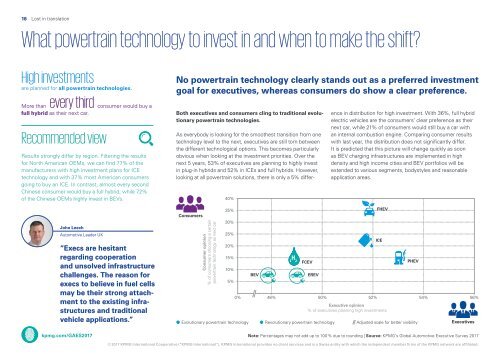Global Automotive Executive Survey 2017
global-automotive-executive-survey-2017
global-automotive-executive-survey-2017
Create successful ePaper yourself
Turn your PDF publications into a flip-book with our unique Google optimized e-Paper software.
16 Lost in translation<br />
What powertrain technology to invest in and when to make the shift?<br />
High investments<br />
are planned for all powertrain technologies.<br />
More than every third<br />
full hybrid as their next car.<br />
Recommended view<br />
consumer would buy a<br />
Results strongly differ by region. Filtering the results<br />
for North American OEMs, we can find 77% of the<br />
manufacturers with high investment plans for ICE<br />
technology and with 37% most American consumers<br />
going to buy an ICE. In contrast, almost every second<br />
Chinese consumer would buy a full hybrid, while 72%<br />
of the Chinese OEMs highly invest in BEVs.<br />
No powertrain technology clearly stands out as a preferred investment<br />
goal for executives, whereas consumers do show a clear preference.<br />
Both executives and consumers cling to traditional evolutionary<br />
powertrain technologies.<br />
40%<br />
As everybody is looking for the smoothest transition from one<br />
technology level to the next, executives are still torn between<br />
the different technological options. This becomes particularly<br />
obvious when looking at the investment priorities. Over the<br />
next 5 years, 53% of executives are planning to highly invest<br />
in plug-in hybrids and 52% in ICEs and full hybrids. However,<br />
looking at all powertrain solutions, there is only a 5% difference<br />
in distribution for high investment. With 36%, full hybrid<br />
electric vehicles are the consumers’ clear preference as their<br />
next car, while 21% of consumers would still buy a car with<br />
an internal combustion engine. Comparing consumer results<br />
with last year, the distribution does not significantly differ.<br />
It is predicted that this picture will change quickly as soon<br />
as BEV charging infrastructures are implemented in high<br />
density and high income cities and BEV portfolios will be<br />
extended to various segments, bodystyles and reasonable<br />
application areas.<br />
John Leech<br />
<strong>Automotive</strong> Leader UK<br />
“Execs are hesitant<br />
regarding cooperation<br />
and unsolved infrastructure<br />
challenges. The reason for<br />
execs to believe in fuel cells<br />
may be their strong attachment<br />
to the existing infrastructures<br />
and traditional<br />
vehicle applications.”<br />
Consumers<br />
Consumer opinion<br />
% of consumers choosing a certain<br />
powertrain technology as next car<br />
35%<br />
30%<br />
25%<br />
20%<br />
15%<br />
10%<br />
5%<br />
0%<br />
Evolutionary powertrain technology<br />
BEV<br />
FCEV<br />
EREV<br />
48% 50% 52% 54% 56%<br />
Revolutionary powertrain technology<br />
FHEV<br />
ICE<br />
<strong>Executive</strong> opinion<br />
% of executives planning high investments<br />
PHEV<br />
Adjusted scale for better visibility<br />
<strong>Executive</strong>s<br />
kpmg.com/GAES<strong>2017</strong><br />
Note: Percentages may not add up to 100 % due to rounding | Source: KPMG’s <strong>Global</strong> <strong>Automotive</strong> <strong>Executive</strong> <strong>Survey</strong> <strong>2017</strong><br />
© <strong>2017</strong> KPMG International Cooperative (“KPMG International”). KPMG International provides no client services and is a Swiss entity with which the independent member firms of the KPMG network are affiliated.



